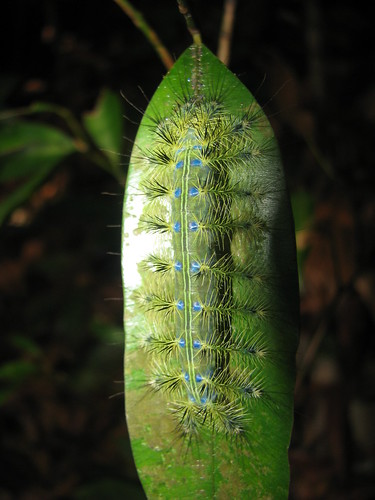Some of the Semakau guides stayed overnight at St John's island the last weekend to try out some of their facilities for future events. December was the monsoon period and it rained heavily during the afternoon. Luckily it stopped just on time for us to visit a small patch of mangroves where the locally rare Avicennia marina was found (unfortunately my picture was too blurred).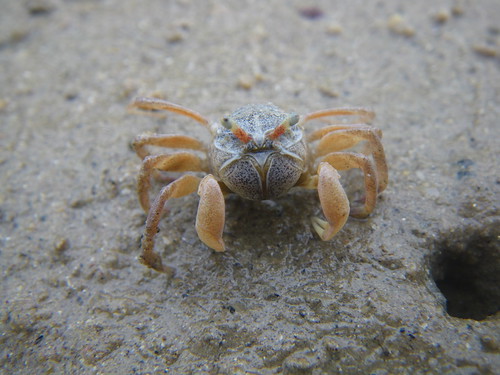
After that, we walked along the intertidals to reach the rocky shores. Along the way, we sawan army of crabs scurrying along the mud. This is the first time I saw the soldier crabs, Dotilla myctiroides moving in such masses, as beach development had decline this crab's numbers that they are listed as vulnerable in our red data book.
There were lots of onch slugs on a pipe leading out to the sea.
The rocky shore is practically covered with sargassum and bryosis seaweeds. However, life can still be found here. Above is a video of a spider conch flipping itself over using its unique sickle-shaped operculum.
July with his keen-eye spotted this Phyllidiella pustulosa nudibranch.
There were also lots of blue coral (Heliopora sp.) near the reef edge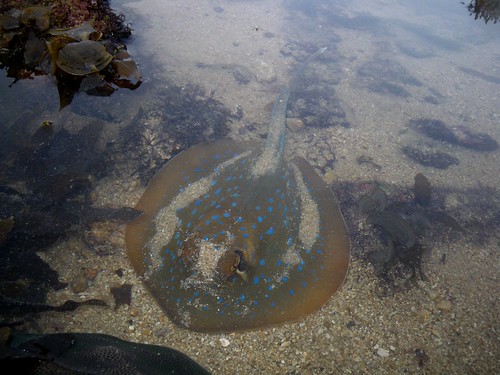
Someone spotted this magnificant juvenile blue spotted fan-tailed ray lying lazily on the sand.
Two brain corals which often confused me. Lobophyllia sp. with its deep gorges between the ridges;
and Symphillia sp.
Nearer to the night, Robert found this flowering sea poison (Barringtonia asiatica).
The next morning when we were at the jetty ready to depart the island, we saw that the high spring tide had raise so high that it was overflowing the concrete banks.
Monday, December 15, 2008
St John's Island exploration
Saturday, December 13, 2008
Luminescent Snail
Quantula striata is a very common land snail found in gardens and forest habitats. It grows up to 5 to 6cm and carrys a somewhat flatten shell horizontally. 
However, as SK shared with me, what is remarkable about this snail is that it is the only known land snail that have the ability to bioluminescent. This is emitted by a photo-organ at its mouth. However, it is more common in the juvenile snails and its eggs while most adults lost this ability. It was hypothesised that the light was used to "facilitate the aggregation of other snails to quickly perishable food" but tests proved it to be false. Seems like so far noone else was able to get a reason for its use.
SK said that the flashing is very faded. I tried taking a small one (the one above on a rubber tree fruit is about 1 cm) in a dark room. Unfortunately, no flashing was seen. Nevertheless, it was still an interesting knowledge gained!
Saturday, December 6, 2008
Mangroves in Pulau Ubin
Today, RY brought a bunch of us to Pulau Ubin to help us familise with the variety of local mangrove species that we have.
Near the jetty, I spotted this pretty Blue Nawab butterfly, Polyura schreiber tisamenus. which had just emerged from its chrysalis. A mangrove butterfly, its caterpillar is known to feed on Bruguiera spp. and Rhizophora spp., but apparently it feeds on the sea hibiscus too.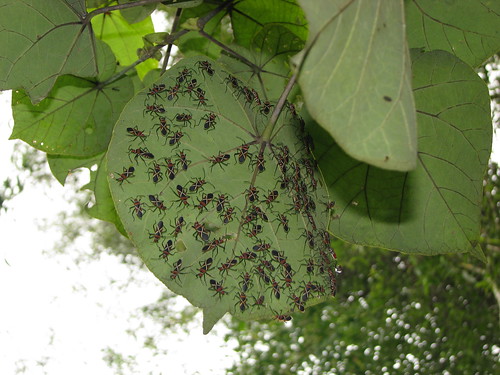
Today was also a good day for seeing the cotton stainer bugs, Dysdercus decussatus which hides in swarms under leaves. They feed on the seeds of the sea hibiscus, Hibiscus tiliaceus.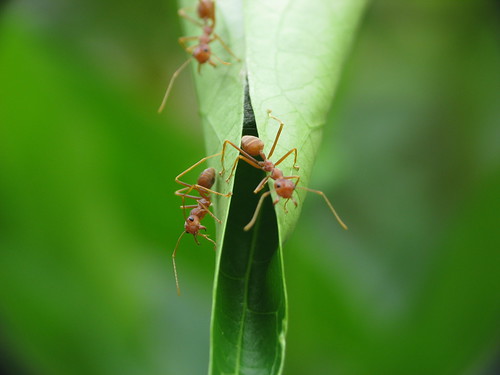
Weaver ants, Oecophylla smaragdina, are also a common insect in the mangroves, especially on the Noni plant, Morinda citrifolia. They are notorious for their painful bite with an injection of acid to the wound.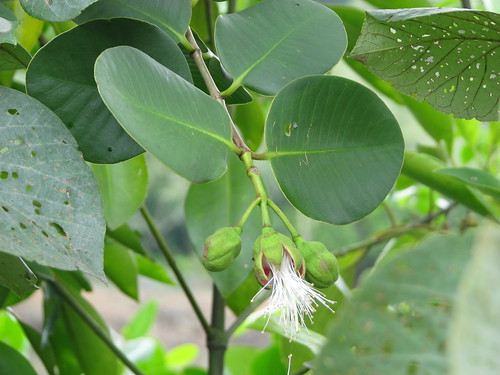
An uncommon local species, Sonneratia ovata, it can be differentiate from S. alba (below) from its more circular leaves and distinct veins.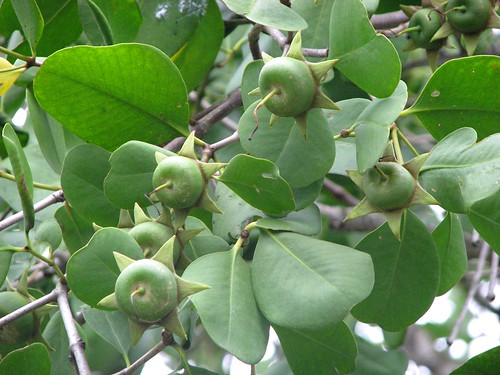
Theres are the the fruits of Sonnertia alba, very rounded and wrapped by a calyx with lobes that bend backwards.
The propagules of Bruguiera cylindrica, like S. alba, has calyx lobes that are bend slightly backwards.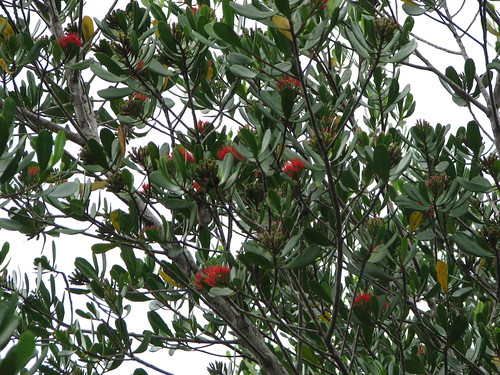
Here is Lumnitzera littorea with its bright red flowers,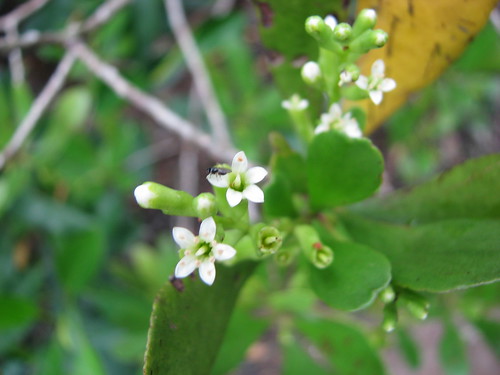
and L. racemosa.
Kacang Kacang, Aegiceras corniculatum means beans in Malay due to its bean like fruits.
A stick insect, but where are its six legs as all insects should have? The front and back pairs of legs are actually extended forward and backwards, possibly to make it resemble more like a branch.
This is Ceriops zippeliana, identifiable from the propagules which have a red collar and patterned calyx.
One of the two highlights of the day. This is not the typical cotton stainer bug, but Dysdercus simon which have a black head instead, feeds on the seeds of the Portia tree, Thespesia populnea. In the Singapore Red Data book, it is classified as endangered and known only one locality between Kranji and Sungei Buloh. This is something worthy to celebrate about seeing it in Pulau Ubin too! 
Walking almost the entire day lost, we were finally rewarded with this Bruguiera hainesii spotted by RY! The malay name, Berus Mata Buaya, meaning crocodile eyes, refer to the large lenticels on the bark, which I unfortunately do not have a picture of.
A tiring but great day spent at Ubin. Thanks RY :)
Sunday, November 2, 2008
Semakau Walk 1st Nov
Yesterday we were back again at Pulau Semakau and I had the chance to guide a group consisting mainly of NUS life science students. It really make me reminisce my school days. 
The tide was still high when we crossed the seagrass meadow. But nevertheless the group was still jovial and enthusiastic. 
Disgused by bits of debri and dead leaves, this is the home of a tubeworm (Class Polychaete). 
The ocellated sea cucumber (Stichopus ocellatus) is described to melt and disintegerate if agitated and brought out of the water for too long. 
The dorsal surface of the gong gong (Laevistrombus canarium) is often camouflaged by a layer of mud to avoid predation. We were really lucky to spot three live ones! 
It would be extremely tough to spot the elbow crab (Parthenope longimanus), named due to their long pair of pincers bending just like an elbow if it did not move about while I was glancing in its direction. 
One of my participants found the processed sand of the acorn worm (Class

The common seastar (Archaster typicus) were all over the sandy intertidals. These stars feed on the detritus using their greenish stomach which they pushed out of their bodies.

We were rewarded with a magnificent sunset halfway towards the reef crest.

Can you spot well disgused octopus in this picture?

This is one organism that I have never seen before. It is not an eel, and seems too agile to be a worm... Hmm...
Wednesday, October 22, 2008
Bukit Timah Hill with Clementi Town Sec
Today me and RY had the opportunity to guide a class from Clementi Town Secondary School after several postponing due to weather conditions.
Going through South View Path, we saw many Gutta Percha (Palaquium gutta) with their characteristic golden underside leaves. These plants have a sticky white sap that is being used as a material in dental fillings due to its inert nature. In the 1900s, many flora were destroyed in the attempt to harvest this plant in order to make insulation cables for submarine lines.
A huge woody climber hanged just across the pathway. Also known as lianas, these plants serve as connectors for many animals like squirrels to move between the trees. However, the unfortunate thing is that if one fell, it will drag down all the other trees that are entwined with it.
The best find of the day: One of the students spotted a huge caterpillar just under a St. Andrew's cross spider! It is a caterpillar of the butterfly, Yellow Archduke (Lexias canescens).
This tall Red Dhoop (Parishia insignis), is named as a heritage tree. This is a program started by Nparks to conserve our mature trees. They are given regular inspection and pruning. Even lightning conductors are installed to protect them against lightning strikes.
The presence of Terentang (Campnosperma auriculata) gave an indication that we are within a disturbed forest as this a tree that is found in a mature secondary forest. The leaves are very distinctive, having a folded pair of "ear-lobes" near the leaf stalk.
This is a very common tree in Bukit Timah and it is also the name of one of our housing estate. The wood of the Tampines tree (Streblus elongatus) is very hard and tough, thus they are used to make tool handles.
The leaf litter plant (Agrostistachys longifolia) has an interest way of getting additional nutrients. Its rosette arrangement of leaves (monopodial branching) helps to trap dead litter between the leaves and they will eventually decompose and obtain the necessary nourishment since the forest floor is very nutrient poor.
The Singapore fern (Tectaria singaporeana) like all ferns, produce tiny spores that allow effective wind dispersal. However, not all the leaves have spores. Only the mature ones will have them on their undersides. Its Malay name is called Paku Biawak, or the Monitor Lizard Fern.
The nutmeg (Myristica sp.) is easily identifiable by the leaf branches which spread out like the spokes of a wheel. Nutmegs are dispersed by birds like pigeons and hornbills, which are becoming rare in the forest. Without these agents, they risked overcrowding and competiton for resources if they all grow in the same vicinity.
This is another species of fern, known commonly as the centipede fern (Blechum orientale). Why? Because the young fronds of these plants actually look just like centipedes!
Turning up to Kruing path, we saw the huge Seraya tree which indicates the presence of a primary rainforest. These huge dipterocarps are an important source of quality timber, also known as meranti in the timber trade.
Anyway, flipping over a dead log found there, I showed the students a termite nest. Termites are actually not very closely related to ants. They do not undergo complete metamorphosis like ants but just having a nymph stage, skipping the larvae and pupae stage all together. They also do not have a distinct separation of their thorax and abdomen like ants, which have a clear "pinched waist".
One of my sharp-eyed students spotted another great find for us. A giant forest ant (Camponotus gigas) nest! These ants usually hunt in small groups or individually so this is indeed a rare sight for me.
This is not the common black house crow that we see in our urban estates. Instead, the Greater racket-tailed drongo (Dicrurus paradiseus) is a forest dwelling bird that have two long feathers extending from the tail. They are also a great mimic of other bird calls.
And of course, the trip will not be complete without the ant plant (Macaranga bancaca). The heart gaster ants (Crematogaster sp.) lives in the hollow stem and feed on the fat-rich globules found within the dark red stipules. In return, they fend off herbivores or other smothering climbers.
Finishing the walk, we had some time to head towards Hindhede Quarry where granite used to be mined. A troop of long-tailed macaques (Macaca fascicularis) were basking at the railings and many juveniles were hanging on to their mum or playing about.
We also managed to see other animals like a stick insect, a jumping spider eating a fly and two clouded monitor lizards (Varanus bengalensis). In fact, one jumped out from the shrubs in front of a student, scaring the life out of her ;p. Unfortunately, I was always engrossed when guiding and usually forget to take photos to blog. A good and eventful day nevertheless I must say, with a bunch of enthusiastic and attentive students who managed to bear with their hunger pangs and spotted lots of animals for me along the way.
Monday, October 20, 2008
Exploring Big Sisters
Yesterday, the Semakau guides had an opportunity to go on an exploratory trip to Big Sisters island.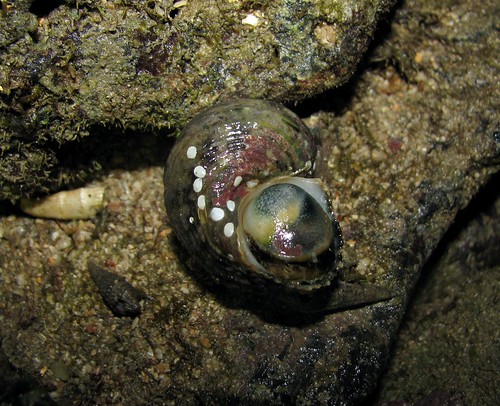
Trying to ID the two species of turban shells that we have locally, I spotted one, probably Turbo burneus (from its rougher operculum) that has white stuff stuck onto its shell. That is probably the eggs of the nerites (Nerita sp.) that were found all over the sea wall. Weird that they will lay them on another live animal though~
This should be the other turban shell, Turbo intercoastalis with its smooth operculum or "cat's eye". These marble like covering was used as buttons in the past.
While we were looking all over the exposed lagoon, July went to search for the endearing land hermit crabs (Coenobita sp.). He found many under a tree and there was one that was too big to hide into its spiral melongena shell (Pugilina cochlidium) so we were able to get a good picture of it.
Octopi are very common in our shores and Robert managed to find one stationary on a rock.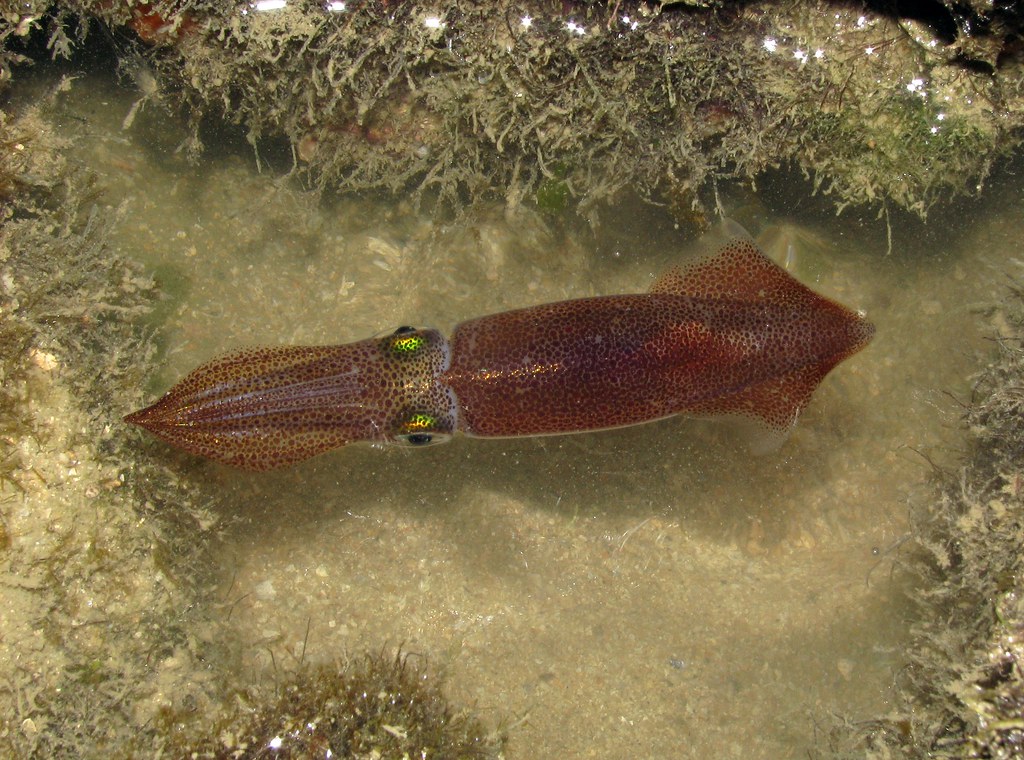
Squids can be normally identifiable by its pair of arrow shaped fins at the end of its body. They also have a thin, transparent quill shaped bone in their body.
There were several genera of hard corals in this lagoon. This is a lettuce coral, Pectinia sp. It can produce lots of muscus when disturbed and it is thought to be one way that can help to remove sediments from itself.
Robert saw this beautiful florescence green Euphyllia sp. Also known as the anchor corals, their tentacles normally end in the shape of an anchor.
This is a turban coral, probably Turbinaria mesenterina. They were so named as some of them can become highly convulated, especially under shallower waters, which is likely to be an adaptative to screen off excess light.
This mat of stuff are zoanthids (Palythoa tuberculosa). Many zoanthids, including this species, incorporate sand to strengthen their tissues as I learnt from Ria's posting when Dr James Reimer came to Singapore.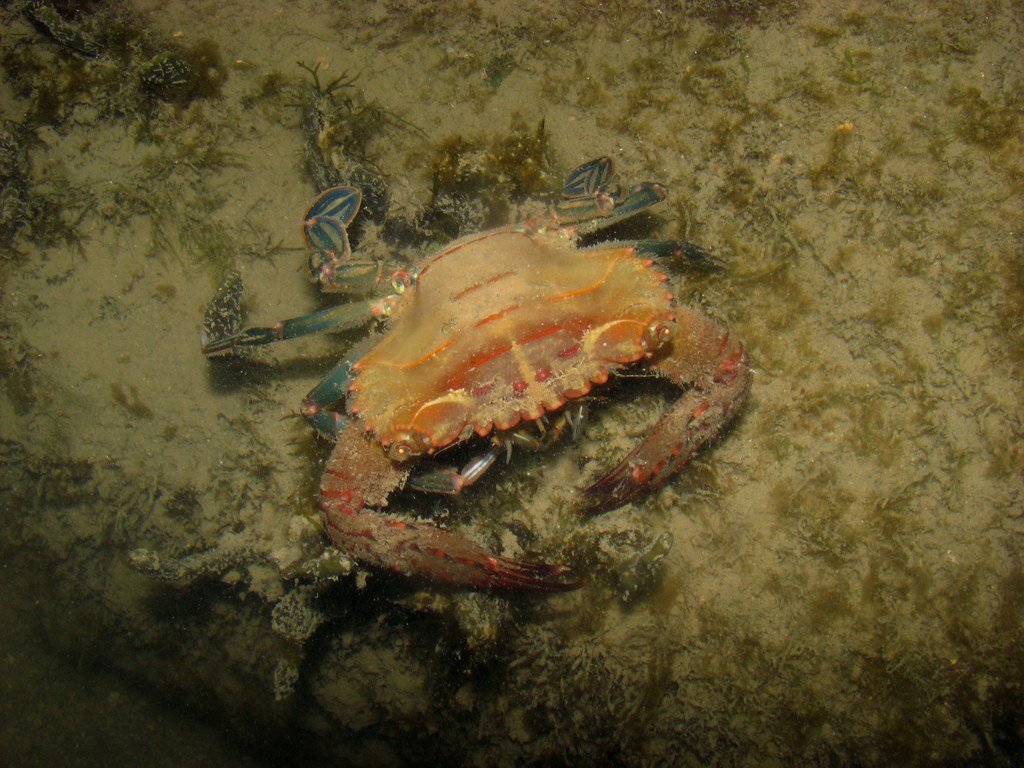
There were lots of red swimming crabs (Thalamita spinimana) at night. This one was grazing on algae. Swimming crabs belong to the family of crabs called Portunidae and they are characterised by their last pair of paddle-shaped legs.
July and the girls found this reef hermit crab (Dardanus lagopodes) inside a spider conch. This was only my second time seeing this, the first from Raffles Lighthouse.
To me, the most interesting find is this orange moon snail with a pretty translucent mantle. I will try to check out the ID later. Update >>> One of our local molluscs expert, Siong Kiat helped to place an ID on this moon snail. It is Natica zonalis.
There was another moon snail beside it. This pearly white moon snail (Polinices mammatus) is probably the most common species in our shores.
Towards the end of the trip, RY found a school of striped eeltail catfish (Plotosus lineatus), seeking safety in numbers.

